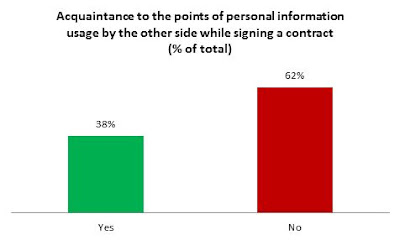By Mariam Arakelyan
CRRC-Armenia Junior Fellow
On July 1st, 2015 the RA Law on Protection of Personal Information came into force. Even though this law replaced the RA Law on Personal data (2002), the notions of “protection of personal information” or “the security of personal information” are relatively new to the Armenian reality.
[1] Data was used in the Agency’s annual report as a preliminary assessment of the current state of personal data protection.
CRRC-Armenia Junior Fellow
On July 1st, 2015 the RA Law on Protection of Personal Information came into force. Even though this law replaced the RA Law on Personal data (2002), the notions of “protection of personal information” or “the security of personal information” are relatively new to the Armenian reality.
To understand individuals’ awareness of what kind of personal information they can obtain, of how their personal information can be used as well as of the means of personal information protection, a small scale pilot survey was administered in Yerevan, Shirak and Syunik regions from November 15 to December 10, 2015 upon the request of the Personal Data Protection Agency of the Ministry of Justice[1].
Regarding the sample composition, 279 adult (18+) residents of the Republic of Armenia took part in this survey, among whom 111 are male and 168 are female, at the same time 144 of them live in capital, 74 in urban and 61 in rural areas.
The aim of this blogpost is to provide a brief discussion of the findings of the survey.
According to the results, 61% of respondents don’t know that in line with the RA law on Protection of Personal Information they have a right to get acquainted with, demand and receive the information on them kept by the state and private organizations.
Chart 1
Moreover,
62% of the respondents don’t read how the personal information they provide
when signing a contract or agreement can be used.
Chart 2
Almost half of the
respondents (47%) are not interested whether they are videotaped or not in the
public places, at the same time only 16% considers it unacceptable (Chart
3). Along with these data, approximately
the same share of respondents (46%) are not worried that organization can keep their
personal information.
 |
Note:
The original question: “Do you get acquainted to the points how information
about you can be used by the other side while signing contract or agreement?”
|
When breaking the data by age,
gender and settlement type, one does not observe notable differences (the
results of the analysis are available upon request).
Chart 3
Chart 4
 |
Note: The
original question: “Are you worried that organizations (state and private) can
follow you or publicize your activity in specific area using the cameras
located in the public places?”
|
 |
Note: The
original question: “Are you worried that organizations (state and private) can
possess your personal information. Please, mention reasons of your concern?”
|
Regarding
the online behavior of the individuals, 49 % of the respondents don’t have profiles
in any social network (these people predominantly belong to 46-65 age-group).
Among those who have profiles 42% keep their profiles open only for friends, 41%
for everyone, while 17% only for selected people.
There are fewer males with no
profiles in social networks (29% of those who don’t use social networks) than
females (71%). Furthermore, it seems that older individuals are less likely to
have social network profiles. In particular, 65% of those who don’t have social
network profiles belong to 46-65 age-group.
To conclude there seems to exist
high level of illiteracy and indifference regarding personal data protection
(at least among our survey respondents). In particular, the majority of the
respondents are not aware of their rights on personal data protection or
concerned with data security.
[1] Data was used in the Agency’s annual report as a preliminary assessment of the current state of personal data protection.
See the summarized data in infographics below.



Comments